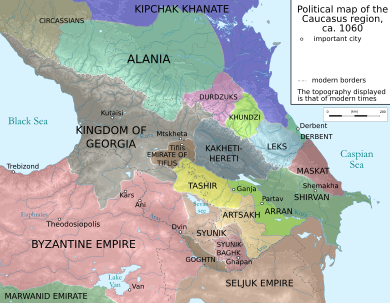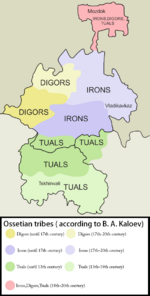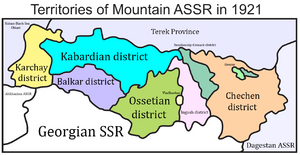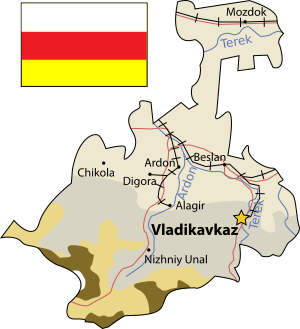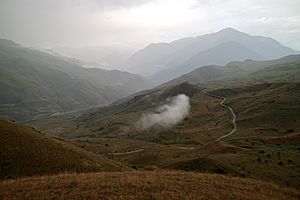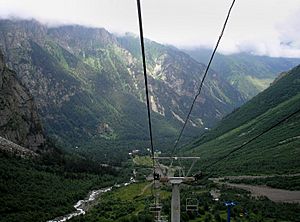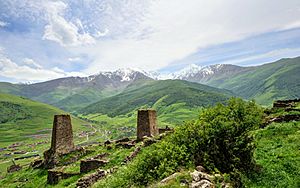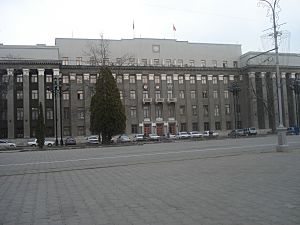North Ossetia–Alania facts for kids
Quick facts for kids Republic of North Ossetia–AlaniaРеспублика Северная Осетия — Алания (Russian) Республикӕ Цӕгат Ирыстон/Иристон — Алани (Ossetian) |
|||||
|---|---|---|---|---|---|
| — Republic — | |||||
|
|||||
|
|
|||||
|
|||||
| Political status | |||||
| Country | Russia | ||||
| Federal district | North Caucasian | ||||
| Economic region | North Caucasus | ||||
| Established | 5 December 1936 | ||||
| Capital | Vladikavkaz | ||||
| Government (as of February 2016) | |||||
| • Head | Sergey Menyaylo | ||||
| • Legislature | Parliament | ||||
| Statistics | |||||
| Area (as of the 2002 Census) | |||||
| • Total | 7,987 km2 (3,084 sq mi) | ||||
| Area rank | 79th | ||||
| Population (January 2015 est.) | |||||
| • Total | 705,270 | ||||
| ISO 3166-2 | RU-SE | ||||
| License plates | 15 | ||||
| Official languages | Russian; Ossetian | ||||
North Ossetia is a republic in Russia. Its full name is the Republic of North Ossetia–Alania. It is located in the North Caucasus region of Eastern Europe. About 687,357 people live here. The capital city is Vladikavkaz, which is at the foot of the Caucasus Mountains.
Most people in North Ossetia are Ossetians. They are an ethnic group from the Iranian peoples family. Their language, Ossetian, comes from ancient languages like Alanic and Sarmatian. Unlike many groups in the North Caucasus, most Ossetians are Christians. However, some follow an old Ossetian religion called Uatsdin. There is also a group of Muslims. Other groups living here include Russians and Ingush.
The history of the Ossetia region goes back to the ancient Alans. They created the Kingdom of Alania in the 8th century. They became Christians in the 9th century. In the 13th century, the kingdom was taken over by the Mongols. By the 17th century, it was under the rule of Safavid Iran. From 1774 to 1806, Ossetia slowly became part of the Russian Empire. This split the region into a northern part and a southern part. This division continued when the Soviet Union was formed. North Ossetia became part of the Russian SFSR. South Ossetia became part of the Georgian SSR.
After the dissolution of the Soviet Union, North Ossetia faced some challenges. In 1992, there was a short conflict between Ossetians and Ingush people. The republic also felt the effects of the Second Chechen War. A very sad event was the Beslan school siege in 2004. Today, there are still talks about uniting North and South Ossetia into one area within Russia.
Ossetian cuisine is a very important part of Ossetian culture. Their special pies, like Fydzhin (a meat pie), are famous. The idea of "three pies" is very symbolic. It represents the Sun, Earth, and water.
Contents
Understanding North Ossetia's Name
In the last years of the Soviet Union, people in North Ossetia wanted to bring back the name of Alania. This was a medieval kingdom of the Alans.
The name "Alania" quickly became popular. It was used for businesses, a TV channel, and even a football team. In November 1994, "Alania" was officially added to the republic's name. It became the Republic of North Ossetia–Alania.
Exploring North Ossetia's Geography
This republic is located in the North Caucasus region. The northern part is a flat area called the Stavropol Plain. About 22% of the land is covered by forests.
- Area: About 8,000 square kilometers.
- Borders:
- Inside Russia: Kabardino-Balkaria (west/northwest/north), Stavropol Krai (north), Chechnya (northeast/east), Ingushetia (east/southeast).
- Other Countries: Georgia (including South Ossetia; southeast/south/southwest).
- Highest point: Mount Kazbek (5,033 meters).
- Longest distance north to south: 130 kilometers.
- Longest distance east to west: 120 kilometers.
Rivers of North Ossetia
All the rivers in North Ossetia flow into the Terek River. Some of the main rivers are:
- Terek River (about 600 km long)
- Urukh River (104 km long)
- Ardon River (101 km long)
- Kambileyevka River (99 km long)
- Gizeldon River (81 km long)
- Fiagdon River
- Sunzha River (278 km long)
Mountains of North Ossetia
All the mountains here are part of the greater Caucasus mountain range. Mount Kazbek is the highest peak at 5,033 meters. The second highest is Mount Dzhimara at 4,780 meters.
Natural Resources
North Ossetia has many natural resources. These include minerals like copper, silver, and zinc. There is also a lot of timber (wood) and mineral water. The republic can also produce hydroelectric power from its rivers. There are also untapped reserves of oil and gas.
Climate
The climate in North Ossetia is moderately continental. This means it has warm summers and cold winters.
- Average January temperature: -5°C
- Average July temperature: +24°C
- Average yearly rainfall: 400–700 mm in the plains; over 1,000 mm in the mountains.
A Look at North Ossetia's History
Early History: The Kingdom of Alania
The land of North Ossetia was first home to various Caucasian tribes. In the 7th century, some Nomadic Alans settled here. They formed the Kingdom of Alania. Later, missionaries from Byzantium helped them become Christians.
Alania became rich because the important Silk Road passed through its land. After the Middle Ages, repeated invasions by the Mongols and Tartars greatly reduced the population. These people are now known as the Ossetians. In the 17th century, Islam was introduced to the region.
Russian Rule (1806–1917)
Conflicts with other empires led Ossetia to form an alliance with Imperial Russia in the 18th century. Russia soon built a military base in Vladikavkaz, the capital. This made Vladikavkaz the first Russian-controlled area in the northern Caucasus. By 1806, Russia fully controlled Ossetia.
Russian rule brought fast development. Industries grew, and railways were built, connecting the region to others. The first books from the area appeared in the late 18th century.
Soviet Period (1917–1990)
After the Russian Revolution in 1917, North Ossetia became part of the Mountain Autonomous Soviet Socialist Republic in 1921. Later, it became the North Ossetian Autonomous Soviet Socialist Republic in 1936. During World War II, Nazi German forces tried to capture Vladikavkaz in 1942 but failed.
On June 20, 1990, the North Ossetian ASSR declared itself an autonomous republic within the Soviet Union. Its name changed to the Republic of North Ossetia–Alania in 1994.
Russian Federation Period (1990–Present)
When the Soviet Union broke apart, the Ossetian people faced problems. They were divided between North Ossetia (in Russia) and South Ossetia (in Georgia). In 1990, Georgia removed South Ossetia's special status. This led to ethnic tensions and many people had to leave their homes.
About 70,000 refugees from South Ossetia came to North Ossetia. There was also a conflict between Ossetians and Ingush people in the Prigorodny District. This conflict caused many Ossetians and Ingush to become refugees. In 1995, North Ossetia–Alania signed an agreement with the Russian government for more self-rule. This agreement was later ended in 2002.
After South Ossetia became independent, some people suggested it should join Russia and unite with North Ossetia. North Ossetia has also dealt with refugees and occasional fighting from nearby conflicts. A very sad event was the Beslan school siege in 2004, carried out by Chechen terrorists.
Administrative Divisions
North Ossetia's Economy
North Ossetia–Alania's economy has been growing well. Between 2005 and 2007, all parts of the economy showed steady growth. The republic's climate and natural resources help its economy. The average monthly wage doubled from 2005 to 2007. This made North Ossetia first in wage growth in the North Caucasus.
The government wants to grow industries, support small businesses, and develop spas and resorts.
Natural Resources, Farming, and Industry
The most common resources are ores containing zinc and lead. There are also deposits of limestone, dolomites, and marble. Many construction materials like clay, sand, and gravel are available. The region also has about 10 million metric tons of oil reserves.
Farming in North Ossetia is diverse. Farmers grow wheat, corn, and sunflowers. They also do horticulture (gardening), viticulture (grape growing), and raise cattle and sheep.
North Ossetia's industries are mostly in Vladikavkaz. Big companies there include Elektrotsink and Gazoapparat. There are also plants that make instruments and automotive electrical equipment. The Sadonsky area focuses on mining and forest industries.
Tourism in North Ossetia
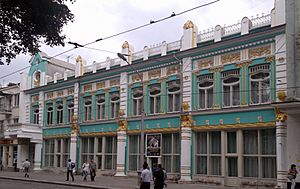
North Ossetia is working hard to develop its tourism. Even though it's near Chechnya, projects for spas, resorts, and tourism are doing well in the mountains. The republic has nearly 3,000 historical sites. More than half of its area is covered by Alania National Park and other nature preserves.
There are over 250 healing, mineral, and freshwater springs. These springs are great for health spas. Their unique mineral water can also be bottled and sold.
Infrastructure
North Ossetia–Alania has good infrastructure. It ranks second in the Southern Federal District for its infrastructure. The republic has one of the best telecommunication networks in the North Caucasus and Russia.
It also has many paved roads. Its transport system connects Russia with the South Caucasus and Central Asia. This includes two federal highways, two customs checkpoints, a railway network, and the Vladikavkaz international airport.
People of North Ossetia
Population: About 712,980 people (2010 Census).
Life expectancy:
| 2019 | 2021 | |
|---|---|---|
| Average: | 75.8 years | 72.5 years |
| Male: | 70.5 years | 68.1 years |
| Female: | 80.6 years | 76.5 years |
Major Cities and Towns
|
Largest cities or towns in North Ossetia–Alania
2010 Russian Census |
||
|---|---|---|
| Rank | Pop. | |
| 1 | Vladikavkaz | 311,693 |
| 2 | Mozdok | 38,768 |
| 3 | Beslan | 36,728 |
| 4 | Alagir | 20,949 |
| 5 | Ardon | 18,774 |
| 6 | Elkhotovo | 12,626 |
| 7 | Sunzha | 11,715 |
| 8 | Nogir | 11,480 |
| 9 | Digora | 10,856 |
| 10 | Kizlyar | 10,813 |
Ethnic Groups
Most people in North Ossetia are Christians who belong to the Russian Orthodox Church. There is also a group of Muslims who speak Ossetian.
According to the 2021 Census, Ossetians make up 68.1% of the population. Other groups include Russians (18.9%), Ingush (3.8%), Kumyks (2.8%), Armenians (1.8%), and Georgians (1.0%). Many smaller groups also live here.
Languages Spoken
North Ossetia has two official languages: Russian and Ossetian. Russian is an official language everywhere in Russia. Ossetian is an Indo-European language, part of the East Iranian group. It is one of the few Iranian languages spoken in Europe. Russian is a East Slavic language. Both languages are related, but distantly.
Religions in North Ossetia
| Religion in North Ossetia–Alania as of 2012 (Sreda Arena Atlas) | ||||
|---|---|---|---|---|
| Russian Orthodoxy | 49.2% | |||
| Other Orthodox | 2.4% | |||
| Protestantism | 0.8% | |||
| Other Christians | 9.8% | |||
| Islam | 4% | |||
| Uatsdin and other native faiths | 29.4% | |||
| Spiritual but not religious | 0.8% | |||
| Atheism and irreligion | 3% | |||
| Other and undeclared | 0.6% | |||
A survey from 2012 showed that 49% of people in North Ossetia–Alania follow the Russian Orthodox Church. About 10% consider themselves Christian but not part of a specific church. Another 2% are Orthodox Christians not linked to Russian churches.
The second largest religion is the Ossetian ethnic religion, called Uatsdin ("True Faith"). About 29% of the population follows this faith. Muslims make up 4% of the population, and Protestants are 1%. Also, 1% of people say they are "spiritual but not religious", and 3% are atheists.
Education
North Ossetia has several important universities and colleges. These include North Caucasus State Technological University, North Ossetian State University, North Ossetian State Medical Academy, and Mountain State Agrarian University. All of these are located in Vladikavkaz.
How North Ossetia is Governed
In the past, during the Soviet Union era, three main people held power. The most powerful was the first secretary of the Communist Party. There was also a chairman for the local council and a chairman for the executive committee.
Since 1991, the Communist Party lost its power. Now, the head of the republic is either appointed or elected. There is also an elected regional parliament.
The main law of the region is the Charter of the Republic of North Ossetia–Alania. The Parliament of North Ossetia–Alania is the law-making body. It creates laws and checks that they are followed. The Republic's Government is the highest executive body. It includes local offices that help develop the region and manage daily matters. The Governor is the top official. They make sure the region's laws follow the Constitution of Russia.
The current head of the Republic of North Ossetia–Alania is Sergey Menyaylo.
Culture
North Ossetia–Alania has six professional theaters. It also has the Ossetian State Philharmonia, which is a big music organization.
Images for kids
See also
 In Spanish: Osetia del Norte-Alania para niños
In Spanish: Osetia del Norte-Alania para niños
- South Ossetia
- Kosta Khetagurov
- Ossetian music
- Styr Nyxas





